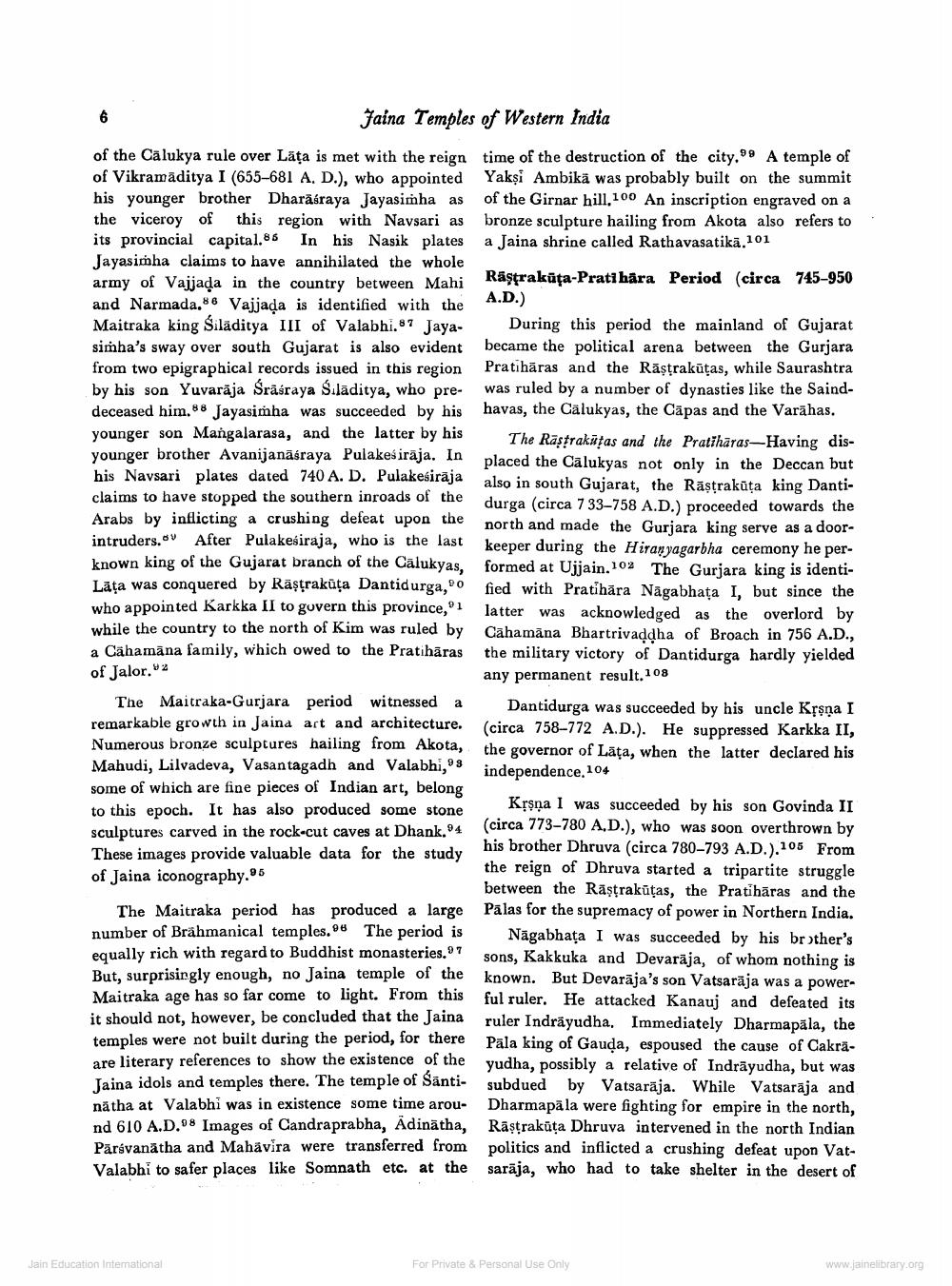________________
Faina Temples of Western India
of the Cālukya rule over Läta is met with the reign time of the destruction of the city.99 A temple of of Vikramaditya I (655-681 A. D.), who appointed Yakși Ambika was probably built on the summit his younger brother Dharăáraya Jayasimha as of the Girnar hill.100 An inscription engraved on a the viceroy of this region with Navsari as bronze sculpture hailing from Akota also refers to its provincial capital.86 In his Nasik plates a Jaina shrine called Rathavasatikā.101 Jayasimha claims to have annihilated the whole army of Vajjada in the country between Mahi Rästrakūta-Prati hara Period (circa 745-950 and Narmada. 6 Vajjada is identified with the A.D.) Maitraka king Siladitya III of Valabhi.87 Jaya- During this period the mainland of Gujarat simha's sway over south Gujarat is also evident became the political arena between the Gurjara from two epigraphical records issued in this region Pratihāras and the Răstrakūtas, while Saurashtra by his son Yuvarāja Srāśraya Siladitya, who pre- was ruled by a number of dynasties like the Sainddeceased him.88 Jayasimha was succeeded by his havas, the Cälukyas, the Cäpas and the Varāhas. younger son Mangalarasa, and the latter by his
The Rastrakūtas and the Pratihāras-Having disyounger brother Avanijanāśraya Pulakes iraja. In
placed the Calukyas not only in the Deccan but his Navsari plates dated 740 A. D. Pulakesirāja
also in south Gujarat, the Rästrakūta king Danticlaims to have stopped the southern inroads of the
durga (circa 7 33-758 A.D.) proceeded towards the Arabs by inflicting a crushing defeat upon the north and made the Gurjara king serve as a doorintruders. After Pulakesiraja, who is the last keeper during the Hiranyagarbha ceremony he perknown king of the Gujarat branch of the Calukyas, formed at Ujjain.102 The Gurjara king is identiLata was conquered by Rästrakūta Dantidurga, fied with Pratihāra Nagabhata I, but since the who appointed Karkka II to govern this province," latter was acknowledged as the overlord by while the country to the north of Kim was ruled by Cāhamāna Bhartrivaddha of Broach in 756 A.D., a Cahamāna family, which owed to the Pratihāras the military victory of Dantidurga hardly yielded of Jalor.2
any permanent result. 108 The Maitraka-Gurjara period witnessed a Dantidurga was succeeded by his uncle Krsna I remarkable growth in Jaina art and architecture. (circa 758-772 A.D.). He suppressed Karkka II, Numerous bronze sculptures hailing from Akota, the governor of Lata, when the latter declared his Mahudi, Lilvadeva, Vasan tagadh and Valabhi,"s independence. 104 some of which are fine pieces of Indian art, belong to this epoch. It has also produced some stone
Krşņa I was succeeded by his son Govinda II
(circa 773-780 A.D.), who was soon overthrown by sculptures carved in the rock-cut caves at Dhank.94
his brother Dhruva (circa 780-793 A.D.).105 From These images provide valuable data for the study
the reign of Dhruva started a tripartite struggle of Jaina iconography.95
between the Rāştrakūtas, the Pratihäras and the The Maitraka period has produced a large Pālas for the supremacy of power in Northern India. number of Brahmanical temples. The period is Nagabhata I was succeeded by his brother's equally rich with regard to Buddhist monasteries.® sons, Kakkuka and Devarāja, of whom nothing is But surprisingly enough, no Jaina temple of the known. But Devarāja's son Vatsarāja was a powerMaitraka age has so far come to light. From this ful ruler. He attacked Kanauj and defeated its it should not, however, be concluded that the Jaina ruler Indräyudha. Immediately Dharmapāla, the temples were not built during the period, for there Pala king of Gauda, espoused the cause of Cakraare literary references to show the existence of the
yudha, possibly a relative of Indrāyudha, but was Laina idols and temples there. The temple of Sānti- subdued by Vatsaraja. While Vatsarāja and nätha at Valabhi was in existence some time arou- Dharmapala were fighting for empire in the north. nd 610 A.D.08 Images of Candraprabha, Adinatha, Rāstrakūta Dhruva intervened in the north Indian Pārsvanatha and Mahävira were transferred from politics and inflicted a crushing defeat upon VatValabhi to safer places like Somnath etc. at the sarāja, who had to take shelter in the desert of
Jain Education International
For Private & Personal use only
www.jainelibrary.org




